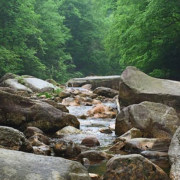All About the Water: The Creation of the Monongahela National Forest
This spring the Monongahela National Forest celebrated its 100th Anniversary. It is generally assumed that national forests were set aside as places to recreate and reflect. In this case, however, those aspirations came later. The creation of the Monongahela National Forest was all about the water.
In the early 20th century lumber barons were clear-cutting the southern Appalachians at an unprecedented rate and the region was paying a price. Average rainfall was stable, but the rivers were behaving badly. In the summer and fall once-reliable streams barely ran. Deckers Creek in northern West Virginia once powered eight sawmills. By 1907 it could support only one.
The swing of the pendulum brought even more dire problems. In March 1907, the Cheat, Tygart, and other mountain rivers raged. Downstream in Pittsburgh the Monongahela hit 36.6 feet. The torrent nearly reached the deck of the Sixth Street Bridge, shut down factories and railroads, and caused about $8 million in damages.
Although the flood cost West Virginia towns about $100 million, it was Pittsburgh’s predicament that got noticed. City leaders developed an ambitious plan to rein in the Monongahela that included building 17 dams throughout the river system. And since the Monongahela flowed into the Ohio and carried national commerce, Pittsburgh (and legislators sympathetic to its beleaguered industries) argued that the federal government should pay the price. It was not likely to be high. Having already destroyed Appalachian lands, lumber companies were now happy to sell them off at bargain prices. What was not for sale could be condemned.
In December 1907, President Theodore Roosevelt duly supported acquisition of eastern forests. “These lands,” he said, “because they form a national asset, are as emphatically national as the rivers which they feed.” Roosevelt apparently believed that the 17 dams would not be necessary, that by protecting what forests remained and planting new ones the federal government could calm the troubled eastern waters.
That is how Gifford Pinchot, the father of forestry in America, explained it to the congressional committee considering Roosevelt’s plan in early 1908. “Mountains are substantially great reservoirs of water,” he explained, demonstrating their destruction in photographs of Appalachian clear cutting.
The legislators presumably understood Pinchot’s point, but conservative congressmen did not care. Some deemed creation of national forests within existing states unconstitutional. “If you can condemn the mountains, you can condemn every foot of land from the mountains to the seaboard,” claimed Georgia Congressman Charles Bartlett. Speaker of the House Joseph Cannon, on the other hand, vowed to spend “not one cent for scenery.” The opposition broke in 1911 with the passage of the Weeks Act. There was no mention of scenery in the bill. It was all about commerce, allowing states to cooperate with each other and the federal government “for the protection of watersheds of navigable streams.”
By late 1915, the Forest Service had begun purchasing land in West Virginia, creating fire protection districts, and blazing trails through struggling secondary growth. On April 28, 1920 President Woodrow Wilson designated the 54,000-acre area the Monongahela National Forest. On its 100th anniversary, the national forest’s 921,000 acres serve, like Pinchot had intended, as a “great reservoir of water,” that (usually) keeps the Monongahela within its banks and the city of Pittsburgh above water.
